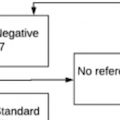Abstract
Background: Rapid diagnostic tests (RDTs) for influenza used by individuals at home could potentially expand access to testing and reduce the impact of influenza on health systems. Improving access to testing could lead to earlier diagnosis following symptom onset, allowing more rapid interventions for those who test positive, including behavioral changes to minimize spread. However, the accuracy of RDTs for influenza has not been determined in self-testing populations.
Objective: This study aims to assess the accuracy of an influenza RDT conducted at home by lay users with acute respiratory illness compared with that of a self-collected sample by the same individual mailed to a laboratory for reference testing.
Methods: We conducted a comparative accuracy study of an at-home influenza RDT (Ellume) in a convenience sample of individuals experiencing acute respiratory illness symptoms. Participants were enrolled in February and March 2020 from the Greater Seattle region in Washington, United States. Participants were mailed the influenza RDT and reference sample collection materials, which they completed and returned for quantitative reverse-transcription polymerase chain reaction influenza testing in a central laboratory. We explored the impact of age, influenza type, duration, and severity of symptoms on RDT accuracy and on cycle threshold for influenza virus and ribonuclease P, a marker of human DNA.
Results: A total of 605 participants completed all study steps and were included in our analysis, of whom 87 (14.4%) tested positive for influenza by quantitative reverse-transcription polymerase chain reaction (70/87, 80% for influenza A and 17/87, 20% for influenza B). The overall sensitivity and specificity of the RDT compared with the reference test were 61% (95% CI 50%-71%) and 95% (95% CI 93%-97%), respectively. Among individuals with symptom onset ≤72 hours, sensitivity was 63% (95% CI 48%-76%) and specificity was 94% (95% CI 91%-97%), whereas, for those with duration >72 hours, sensitivity and specificity were 58% (95% CI 41%-74%) and 96% (95% CI 93%-98%), respectively. Viral load on reference swabs was negatively correlated with symptom onset, and quantities of the endogenous marker gene ribonuclease P did not differ among reference standard positive and negative groups, age groups, or influenza subtypes. The RDT did not have higher sensitivity or specificity among those who reported more severe illnesses.
Conclusions: The sensitivity and specificity of the self-test were comparable with those of influenza RDTs used in clinical settings. False-negative self-test results were more common when the test was used after 72 hours of symptom onset but were not related to inadequate swab collection or severity of illness. Therefore, the deployment of home tests may provide a valuable tool to support the management of influenza and other respiratory infections.
